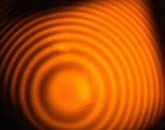Fabry-Perot Interferometer
| This interferometer makes use of multiple reflections between two closely spaced partially silvered surfaces. Part of the light is transmitted each time the light reaches the second surface, resulting in multiple offset beams which can interfere with each other. The large number of interfering rays produces an interferometer with extremely high resolution, somewhat like the multiple slits of a diffraction grating increase its resolution. |  |

Interference concepts
Example of sodium doublet
| HyperPhysics***** Light and Vision | R Nave |




